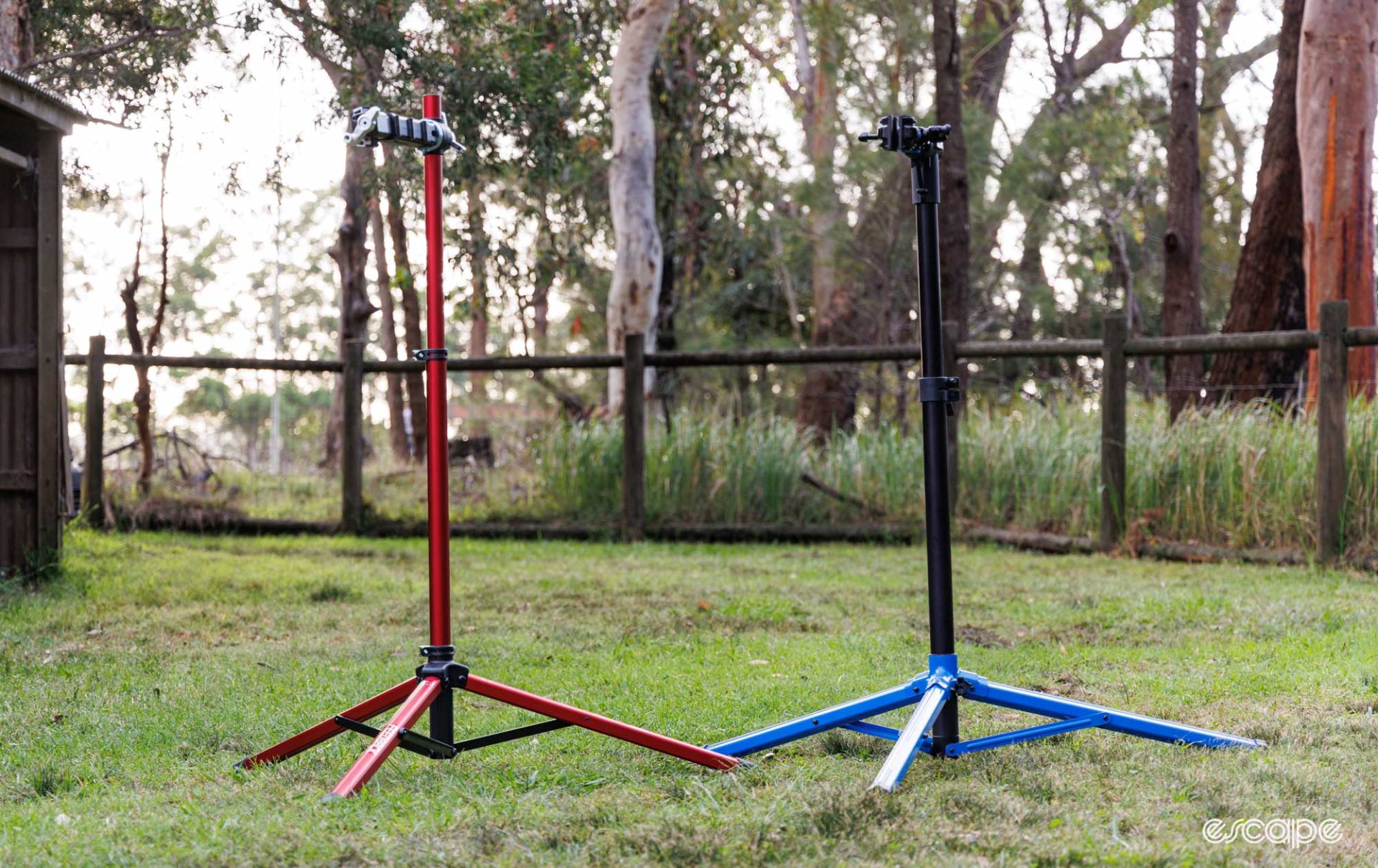When I think about some of my best purchases, a 2004 Ultimate Support repair stand ranks highly. I was an awkward, pasty teenager when I got it, and it proved an immediate facilitator in my obsession with working on bikes. Nearly two decades later, I’m still awkward and pasty, and that repair stand continues to function like new after who knows how many hours of holding bikes. That’s some investment!
A repair stand forms the centre of any bicycle workshop. Even if you don’t get too detailed with your servicing, a repair stand can be a game changer for cleaning a drivetrain or adjusting a derailleur. My experiences with a good repair stand align with those of countless others who invested in similarly high-quality options, and today, I still believe that spending a little more on a good repair stand will ensure it’s the last one you buy.
With that, I wanted to compare the two benchmark folding (portable) repair stands on the market: the Park Tool PRS-26 Team Issue and Feedback Sports Pro Mechanic. Both are relatively new iterations of proven products that have become a staple at many professional cycling events. They each emphasise a balance of solid stability and ease of storage/portability. And while they look similar, they offer enough unique elements to set them apart.
Whether you’re interested in spending for these pro-level folding models or want something cheaper from either brand, this comparison review should offer insight into the features to look for and the compromises between them.
The value in spending more
For many, a low-cost repair stand from Aldi/Wiggle/insert-seller will perform the desired task of holding a bike. I’ve reviewed such stands before, and while I would spend more, I acknowledge that they do an admirable job of holding a bike for a relatively small sum of money.
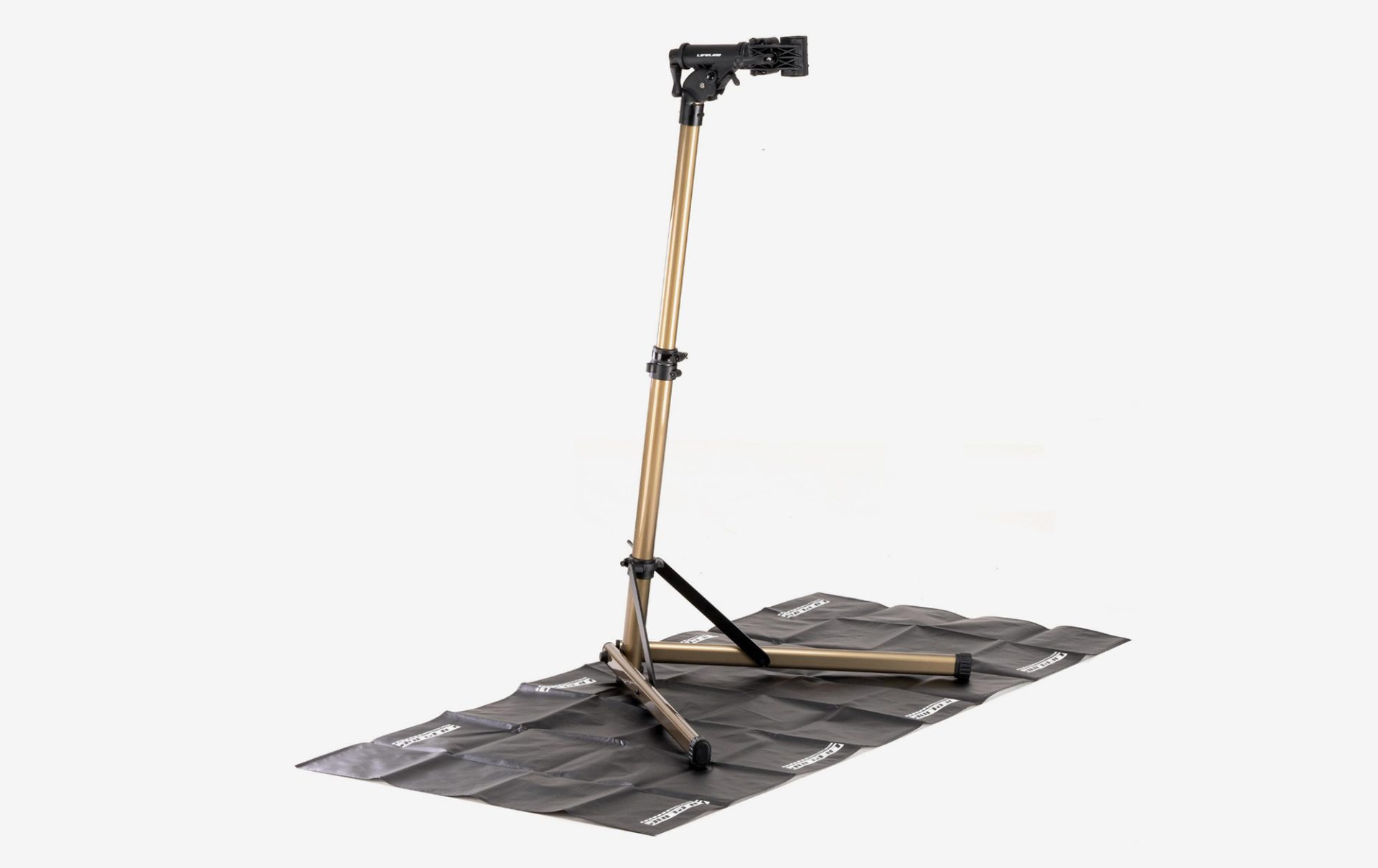
My biggest pet peeve with almost all of those budget stands is the inability to smoothly and easily adjust the angle of a clamped bike. A feature I use most on any repair stand, being able to tilt a bike has become increasingly important when working with gravity for tasks like bleeding disc brakes and routing internal cables.
Spending more typically means a modest price jump to entry-level stands from brands such as Park Tool and Feedback Sports. These are specialist companies with a proven track record in valuing service and repair of their products.
As you work your way up through the price tiers, the more premium stands feature clamps that are easier and faster to use. The way they fold and adjust improves. They can hold bikes at a more comfortable (higher) working height, are stiffer, and more stable in use. And while such stiffness sounds silly, it feels more comforting while you’re applying loads to undo a pedal, knock a rusty headset bearing out, or are trying not to bounce a bike with a Shimano bleed cup waiting to spill.
The stands tested here aim to do all that in a package that’s still lightweight and compact to carry or stow away. It is easier to set up a light stand versus a heavy one. Speaking of heavier options, Feedback Sports has the Pro Mechanic HD, which is a wholly burlier version of the tested Pro Mechanic built with heavy e-bikes in mind. Meanwhile, in Park Tool’s catalogue, you have both heavier folding stands and non-portable shop options to consider.

The right tool for the job
It’s also worth noting that as both the Park Tool PRS-26 and Feedback Sports Pro Mechanic are rather new products, there are the older options still readily available for purchase. The Park Tool PRS-25 remains in the line-up and has a higher load capacity, but is more cumbersome once folded and isn’t as stable on uneven ground. Meanwhile, the existing Feedback Sports Pro Elite doesn’t match the clamp angle holding strength, shorter jaw height, and quick spinner clamp as the new Pro Mechanic, but it remains an exceptionally good option.
If you’re building a dedicated bicycle workshop or garage workspace and want a dedicated stand for the place, then a shop repair stand is worth considering. They’re unbeatable for how rigidly they hold a bike, and you’ll never trip over a work stand leg in the process. The Park Tool PRS-3.3-2 is a common choice, Unior has something similar, and Remco is a new entrant offering electric assistance at a competitive price. For everyone else that needs a stand that can be folded away, or be taken on a riding holiday, then a folding workstand is the way to go.
Alternatively, there are race-style stands to consider (such as the Topeak Prepstand X, Park Tool PRS-22.2 or Feedback Sports Sprint). These support the bike from the bottom bracket and are a common sight amongst professional road race mechanics, but increasingly rare elsewhere. They can be a pain to use across the various axle standards and frame shapes that exist today, though the biggest barrier is disc-brake bikes. Race-style stands only allow you to have one wheel in the bike at a time – that’s annoying and explains why you rarely see them in use at bike shops.
Round one: Portability and price
Across all disciplines of cycling, both Park Tool and Feedback Sports are well-established brands with their roots in repair stands. Park Tool’s first product some 55 years ago was a shop repair stand, while Feedback Sports was born from Ultimate Support, a leading brand in stands and supports for speakers, microphones, keyboards and other can’t-afford-to-be-dropped things for musicians.
Known as the “blue tool” company, Park Tool has long dominated the market of shop repair stands, while Feedback Sports’ distinctive red-anodised products have catered to the hearts of travelling pro mechanics and enthusiast home users. While the two companies have always offered products that compete with each other, it’s only recently that the blue brand started to make a tripod-base stand that looks to flatter what the red brand has always done.
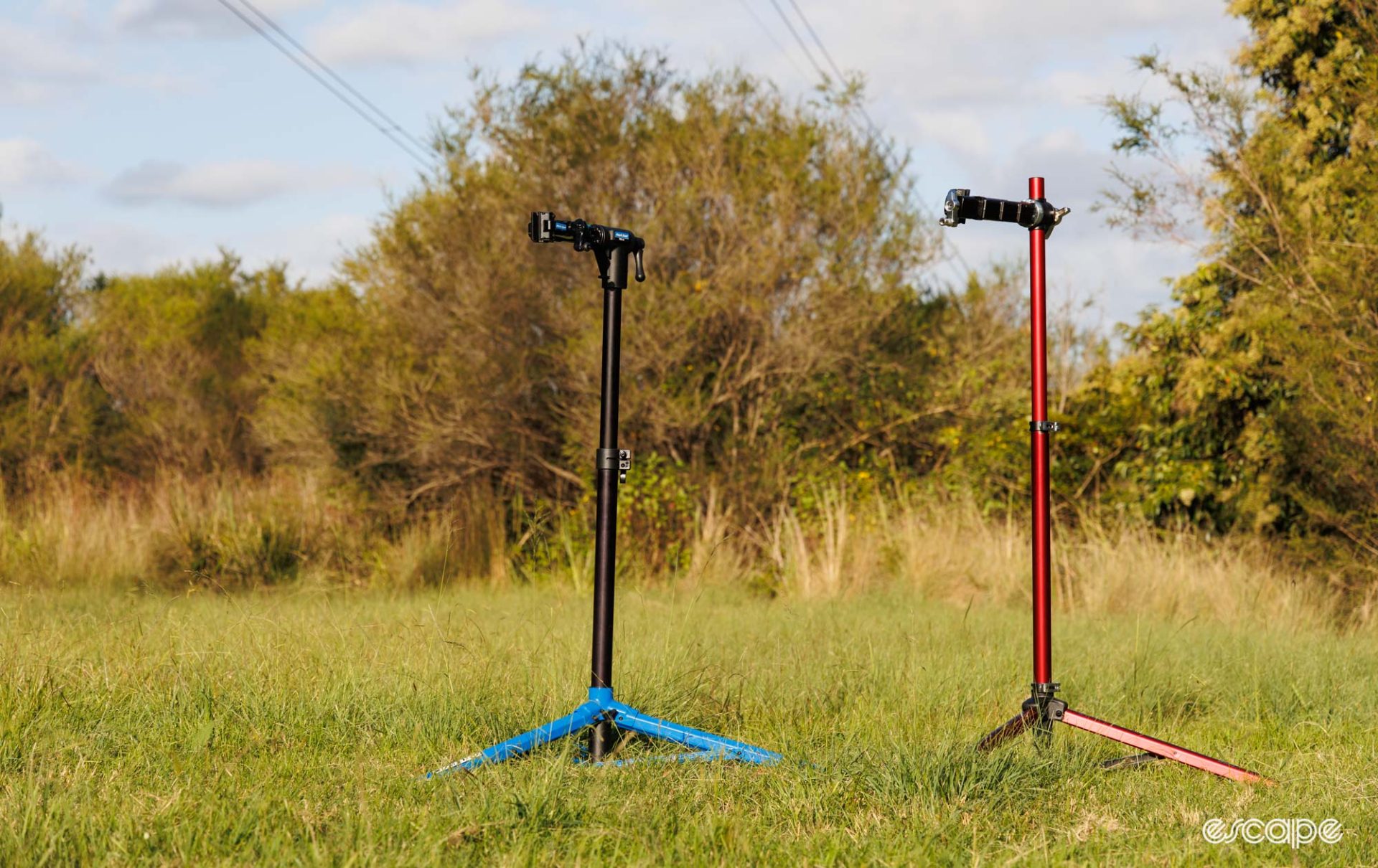
The two stands each feature a foldable tripod base with a telescoping centre column. Each is designed with washing bikes in mind with a predominately 6063 aluminium construction, both with manipulated tube shapes for greater stiffness at less weight. However, despite such similarities, it’s in the finer details where they stand (totally intended) apart.
The Park Tool PRS-26 is shipped in a flat-pack state, requiring some minor mechano-like assembly where, ironically, a repair stand would be handy. Building it doesn’t take long, but the process shows how industrial some design elements are, with exposed nuts and bolts at all the pivoting points. By contrast, the Feedback Sports Pro Elite comes in a slightly larger recycled cardboard, there’s no plastic in sight, and the stand is wholly assembled and ready to be unfolded into use. Point Feedback.
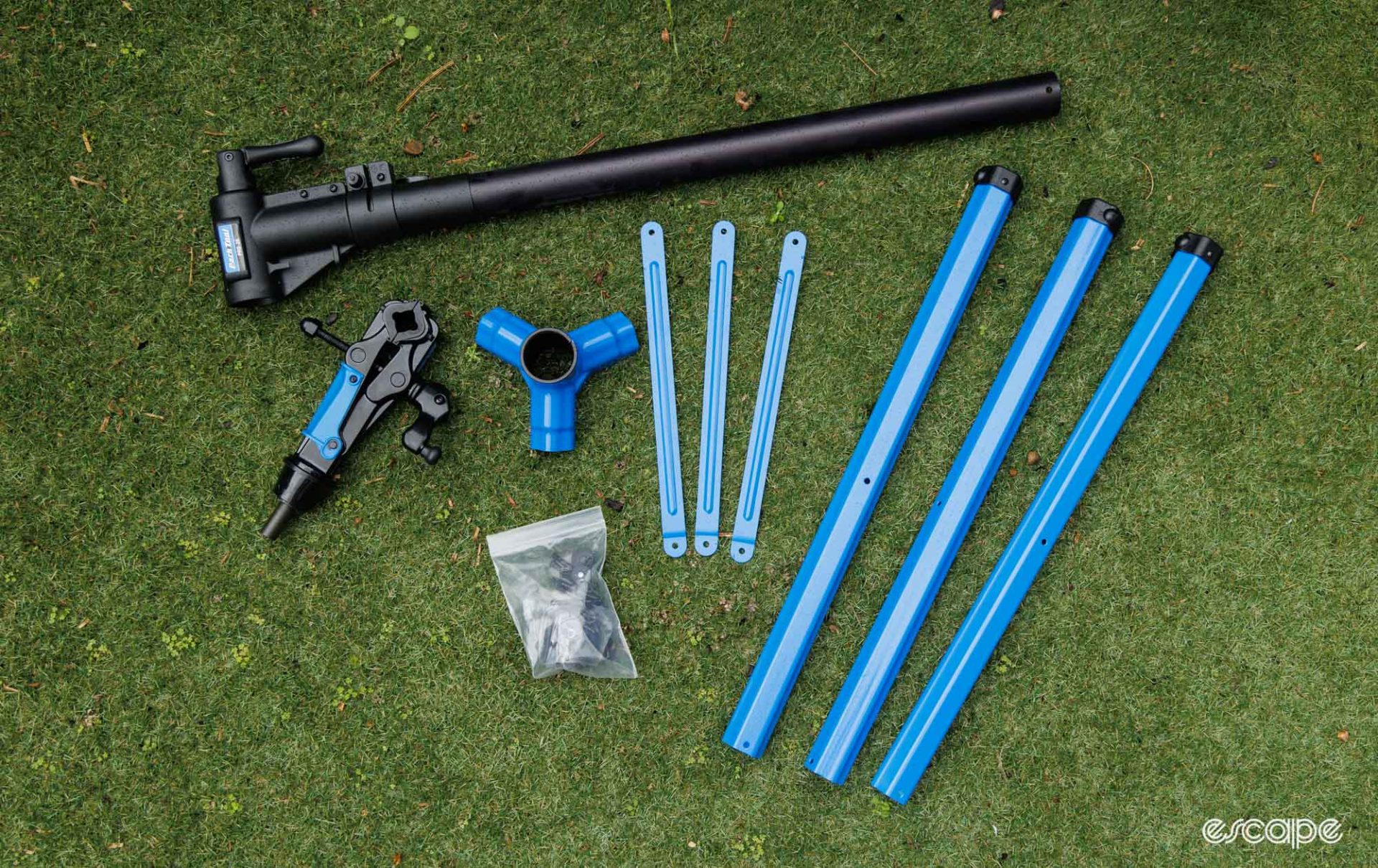

Folded up, the Park Tool PRS-26 offers a more compact 975 mm folded length to the Feedback Sports’ 1,150 mm figure. Both are impressively light for what they hold, with the Park Tool at 5.85 kg, with the Feedback Sports a smidge less at 5.56 kg. We’ll call this a draw.
Park Tool provides its repair stands with a “limited” lifetime warranty, while Feedback Sports offers a less attractive three-year warranty. Warranties are only valuable when the companies stand behind them, in my experience, both companies are typically exceptional with aftermarket customer and product support, even after the warranty period has passed. Given I can still cheaply buy service parts for most 20-year-old Feedback Sports and Park Tool stands, I think a tie is deserved.
Expect to pay US$430 / AU$700 / £460 for the Park Tool PRS-26, while the Feedback Sport’s Pro Mechanic is priced at US$395 / AU$TBC / £TBC. Neither Park Tool or Feedback Sports include a travel/storage bag with its stands, but such products are available for US$26 and US$42, respectively. Related to pricing, Park Tool packages/semi-assembles its stands at its USA facility with a mix of domestic and internationally sourced parts, while Feedback Sports’ is manufactured and assembled in Taiwan. I’ll let you decide who gets the point here.

Round two: Unfolding and stability
The Feedback Sports is vastly smoother in how it unfolds, and its clamp merely pivots by 90 degrees and then Is tightened in place. By contrast, opening the tripod base of the Park Tool requires two hands and care not to pinch fingers, and then you need to thread the clamp into place. Don’t ask me how I know, but misusing Park Tool’s design means the clamp can cause immense pain by falling onto your foot, while Feedback Sports’ attached design prevents such an experience.
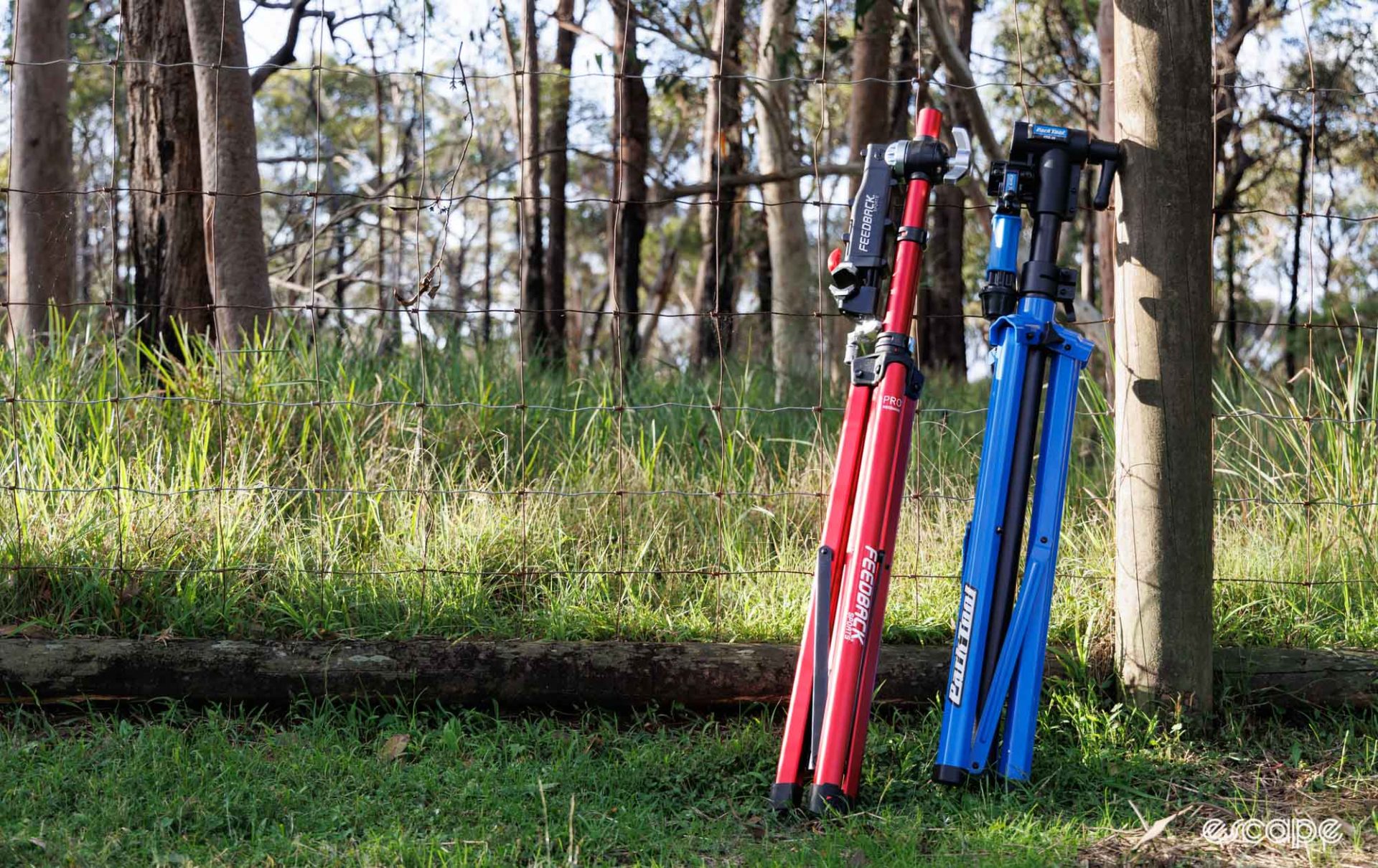
After a few practises, I could unfold the Feedback Sports into action within 17 seconds, while it took me a hurried 30-seconds for the Park Tool and its seperate clamp. Neither are exactly slow, but Feedback is the clear winner in this one, and the time difference is even more obvious when it’s pack-up time. I’m awarding Feedback two points here, one for the better speed, and another for the inability to accidentally drop the expensive clamp onto the floor (or a foot; again, ouch).
Unfolded, the Park Tool has minimum and maximum working heights of 940 and 1,456 mm. While Feedback Sports’ longer folded length results in a minimum height of 1,005 mm, and places the maximum height at a noticeably more impressive 1,652 mm. By comparison, Park Tool’s PRS-3.3-2 shop repair stand has a maximum working height of 1,654 mm. I’m not all that tall at 170 cm, and yet my preferred working height for a work stand is right around the 1,600 mm mark; yep, another point to Feedback Sports.
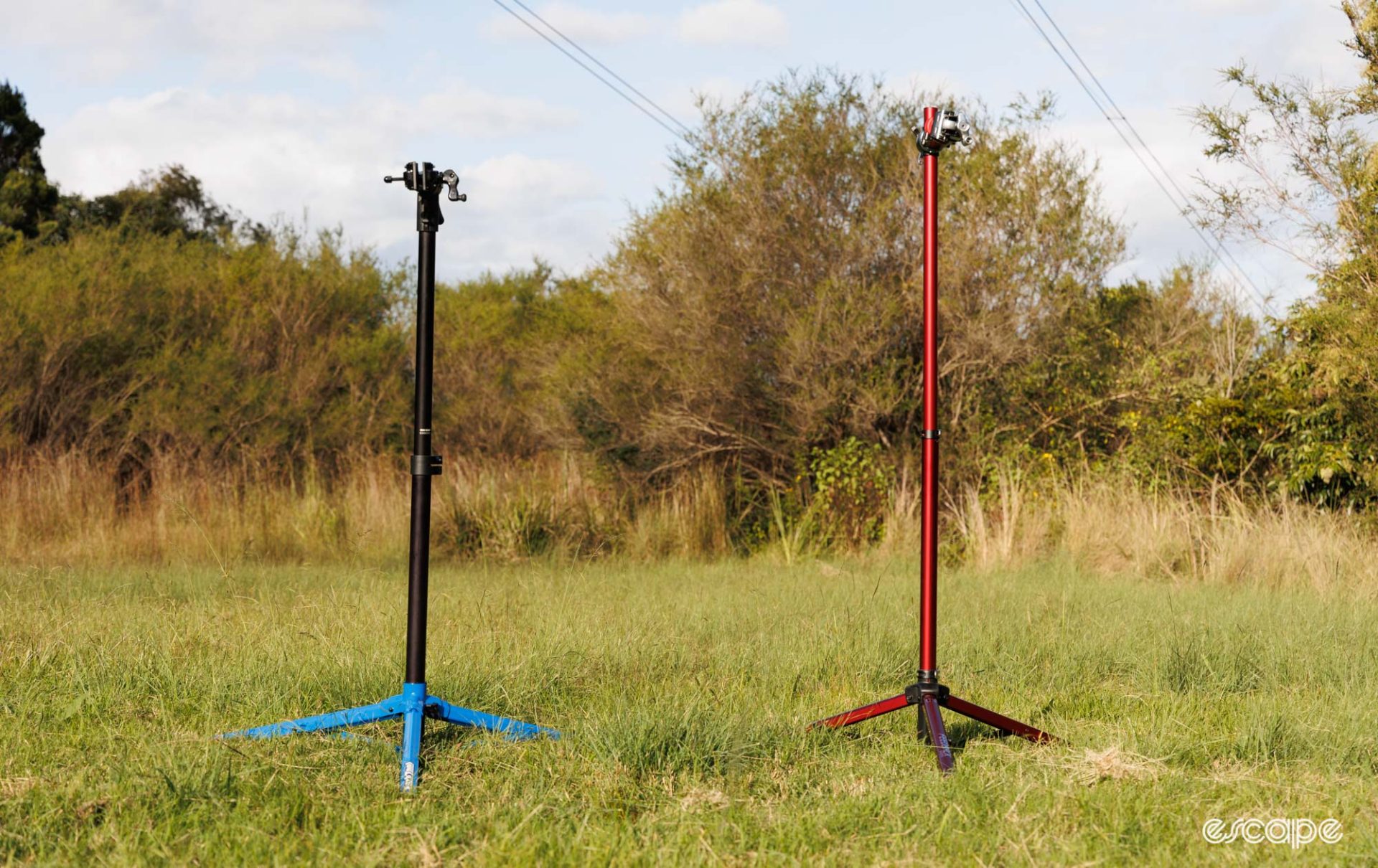
The PRS-26 and Pro Mechanic are weight-optimised for easy portability. Take the claimed maximum working load capacities with a grain of salt as there’s no agreed-upon standard of testing, but Park Tool quotes 36 kg (about 80 lbs) for its PRS-26, while Feedback Sports quotes 34 kg (75 lbs) for the Pro Mechanic. As a result of that, neither of these stands is the ideal pick for hoisting up the family cargo bike.
Feedback Sports goes a step further to suggest its Pro Mechanic stand is “optimised” for bikes under 18.1 kg (40 lb), while it recommends its far bulkier (it’s a beast) Pro Mechanic HD stand for those regularly working on heavier bikes (max load limit of 45.5kg (100 lbs). Park Tool also offers folding stands with equal increased capacity limits in the PRS-25 and PCS-4.2.
These load limits are based on absolute strength, stiffness, and stability. With each stand set to a working height of 1,456 mm (the PRS-26’s maximum), I found the PRS-26’s hexagonal-formed tripod legs and keyed upper tube provide the stand with a higher level of stiffness (less bounce) under a given load. Point to Park Tool.
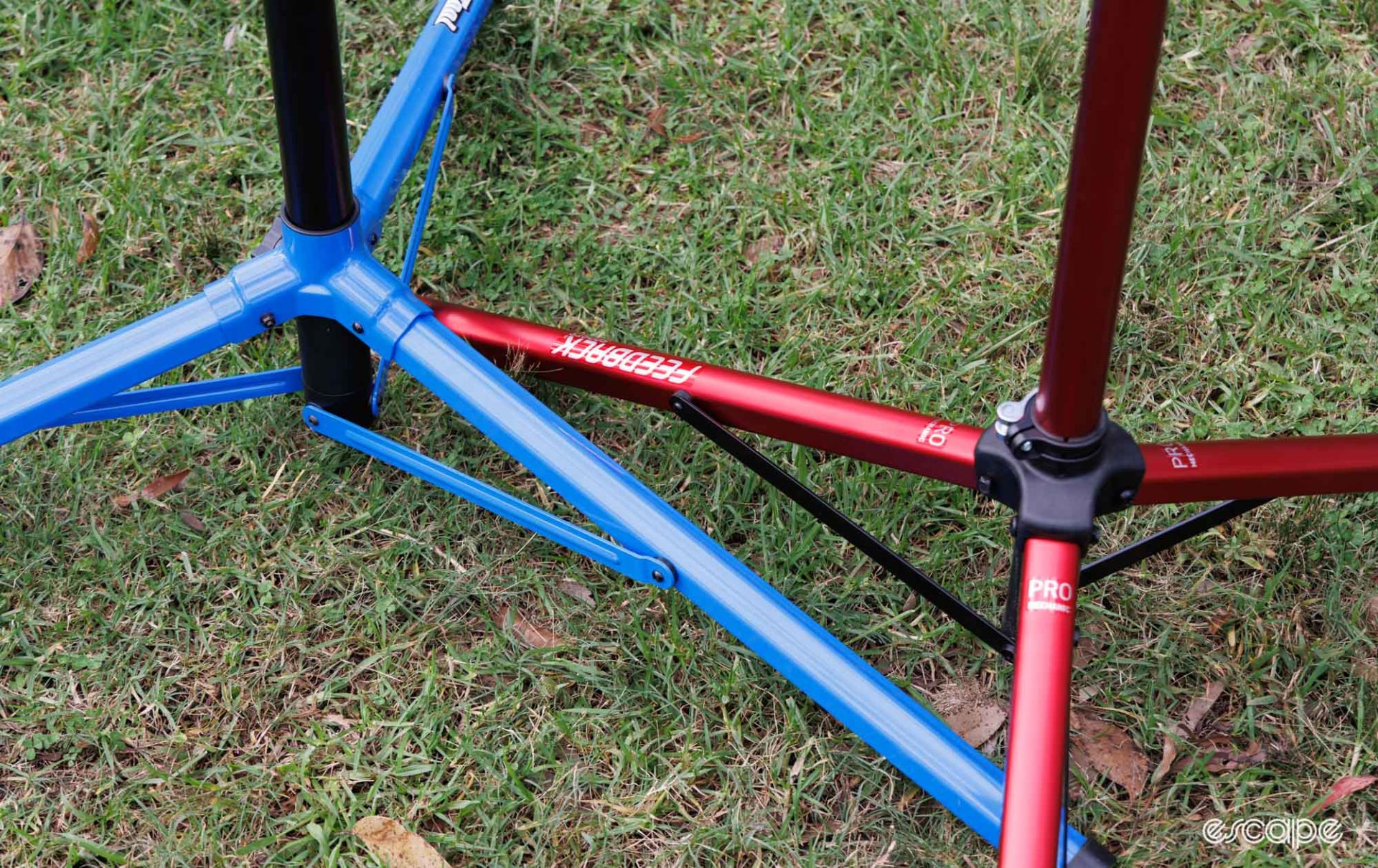
Meanwhile, there isn’t much that separates these two in stability, with Park Tool offering a leg-span (measured between tips of adjacent legs) of 1,250 mm to Feedback Sports’ 1,210 mm figure. Both allow you to place the bike’s weight over either one leg or two, and the tripod design is more stable on uneven terrain than a two-legged stand. Feedback Sports supports its stand footprint with grippier rubber feet (socks?), while Park uses a harder plastic. It’s subjective, but I will award the point to Feedback because those rubber feet are of benefit, while the Park can slide around a bit on tile or similar hard, smooth flooring.
Then we come to the ease of adjustment. Both stands feature quick-release levers for adjusting the height, Feedback’s design employs more metal, feels higher-end and looks more integrated, while Park’s offers tool-free tension adjustment. Point to Feedback Sports for not looking like something I 3D printed at home.

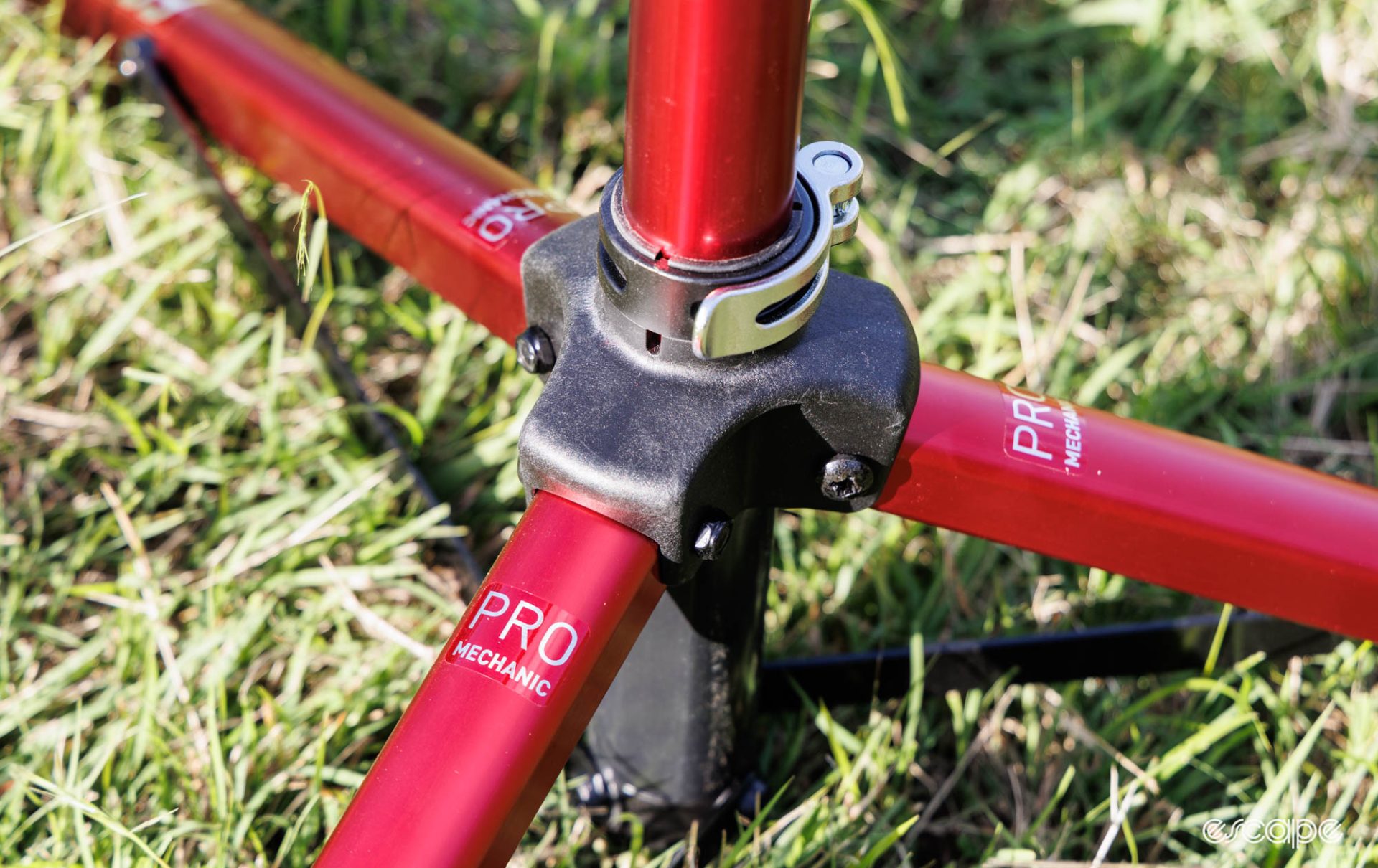
Both stands are also excellent at firmly holding a set angle of the clamp, which wasn’t always the case with older Feedback Sports stands. However, Park Tool has the edge for smoothly allowing a change of angle to the clamp without jerking the bike, while the Feedback Sports has more initial resistance. I couldn’t live without the angle adjust feature, and while both are great, Park Tool gets the point for being as smooth as a shop stand in this sense.
Feedback Sports’ better finish and more integral design is holding up better from an aesthetic point of view. By comparison, the PRS-26 is looking a little weathered after almost a year of casual use, with a few spots of scoring on the lower legs and hints of surface rust on a few of the bolts. It’s mostly cosmetic but point to Feedback Sports.
Round three: Big differences in the clamp
Arguably, the most important element to any good work stand is the clamp. Both of these tested stands offer a clamp intended to safely hold a bike via the seatpost (please don’t clamp that delicate top tube), but they go about it from different directions.
The PRS-26 features Park Tool’s 100-25D Micro-Adjust clamp, the same as the company’s shop stands. Assuming the seatpost is in a vertical position, it clamps front and back (I’ll come back to this critical point), and can be opened to grasp onto objects up to 76 mm in depth.
Park’s design adjusts to different sizes by turning the spinner knob on the side. When approximately near, the quick-release style cam-action clamp speeds the closure, with final tensioning then done by tightening the handle. To release the bike, you unwind the knob to remove tension from the thread, and then open the quick-release. It’s a design that’s vastly more rapid in use than it sounds and offers precise clamping control.

By comparison, the Pro Mechanic stand features a newly overhauled clamp that claims to grasp onto things faster and hold more securely than before. A big point of difference is that Feedback Sports’ stands clamp objects from side-to-side (there is a hack for this), with room to handle up to 66 mm in width.
Feedback Sports’ design uses a more intricate and enclosed “Speed Ratchet” design that freely slides open and closed when no tension is applied to it. To clamp a bike, you slide or squeeze the clamp until it’s touching on both sides, then use the new spinner knob to quickly add tension and fine-tune the clamping force. To release, you can reverse the steps, or more enjoyable, there’s a big eject button on the side that you can hit while humming the sad moment song from Top Gun (the original, of course).
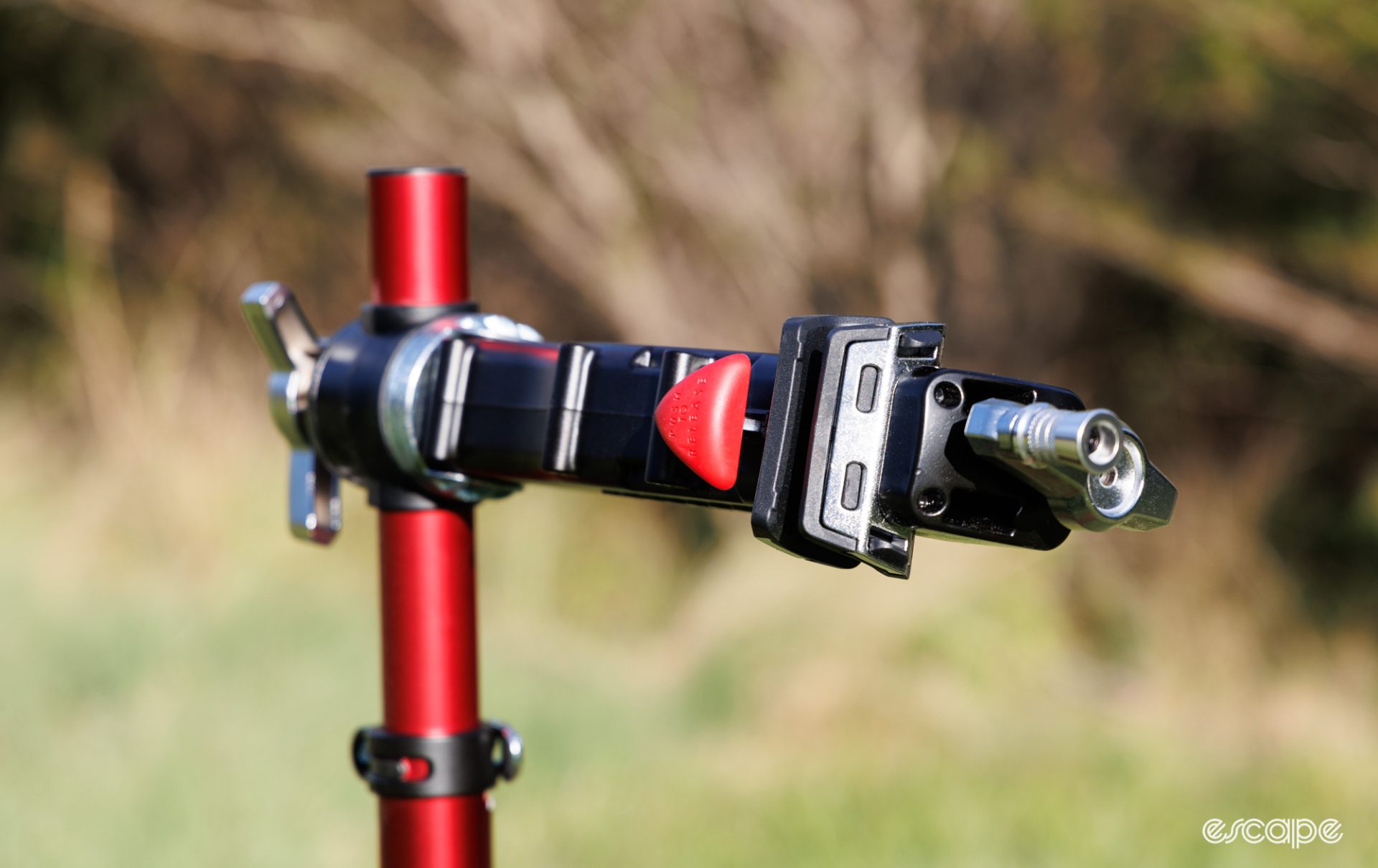
This may come as a shock to some, but I prefer the operation of the simpler Park Tool clamp. It takes practice, but I can more quickly get it to take the load of the bike without having to adjust the position of my hand that’s doing the clamp. Similarly, I find the release more controlled and less abrupt. No doubt the Feedback design is more fun and a cleaner design, but I’ll give the point to Park for pure practicality.
A feature I see overlooked too often is the height of the clamping jaws. A taller jaw increases the clamping surface area, but it comes at the obvious cost to where it fits. A shorter jaw gives you a better chance at clamping a seatpost without having to raise it or remove accessories. And in the case of droppers, a shorter jaw height gives you a greater chance to clamp by the exposed post section, rather than the sliding surface above. The PRS-26 and Pro Mechanic are great in this regard, with the former having a jaw height of 70 mm and the latter a more shapely 83 mm height. Both offer easily replaceable rubber jaw covers with closely comparable durometers. Once again, both of these stands offer jaw heights leaps and bounds better than most other options in the market, but Park has the edge.
Ok, back to the all-important direction of clamping. As a refresher, the Park clamps front-to-back, while the Feedback closes side-to-side. This makes squat of a difference when clamping a round-shape tube. It’s also somewhat of a wash on most newer D-shaped seat posts that are effectively a truncated round shape. Where it matters is in elongated tube shapes, such as airfoil seatposts and similarly funky shapes.
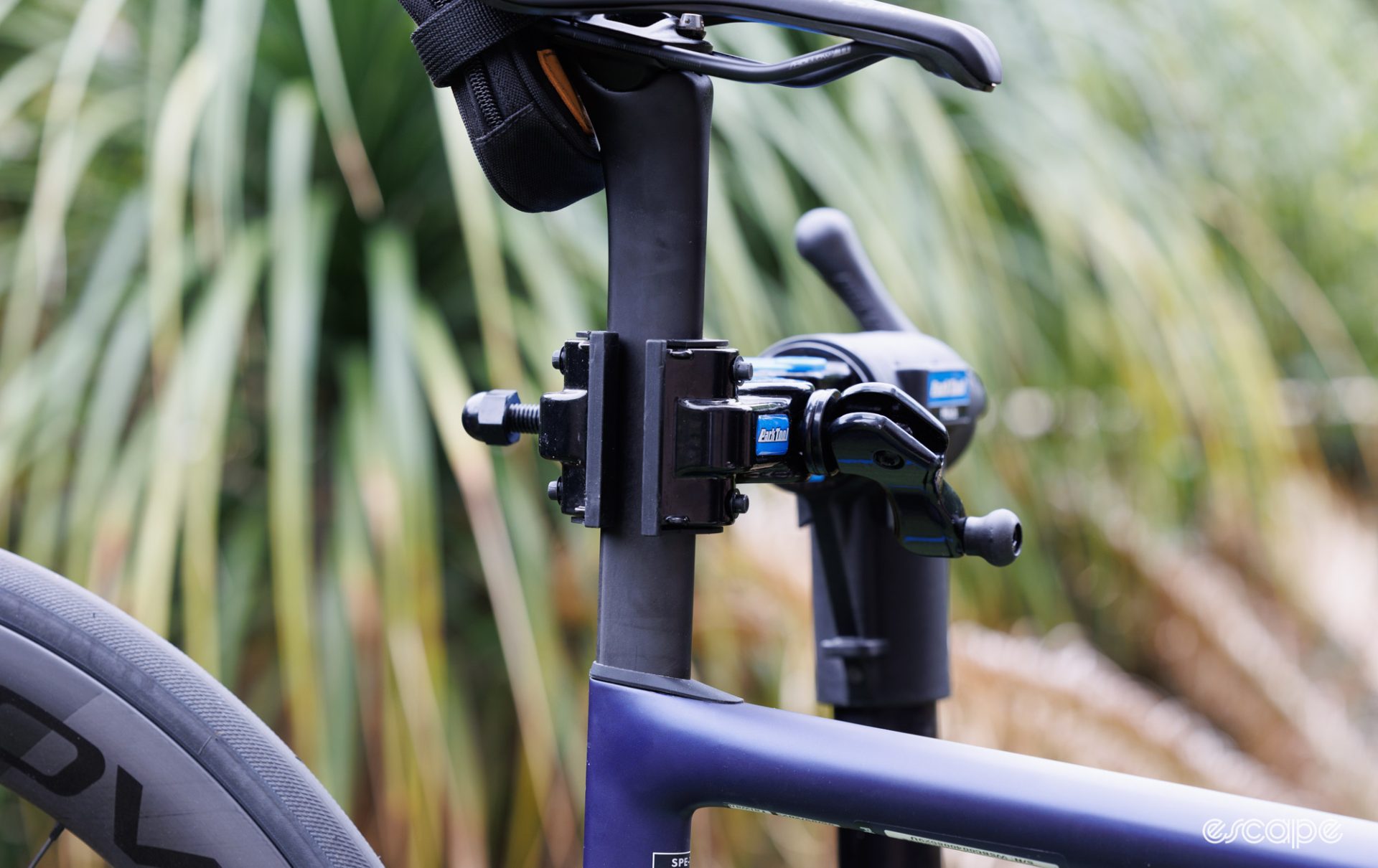
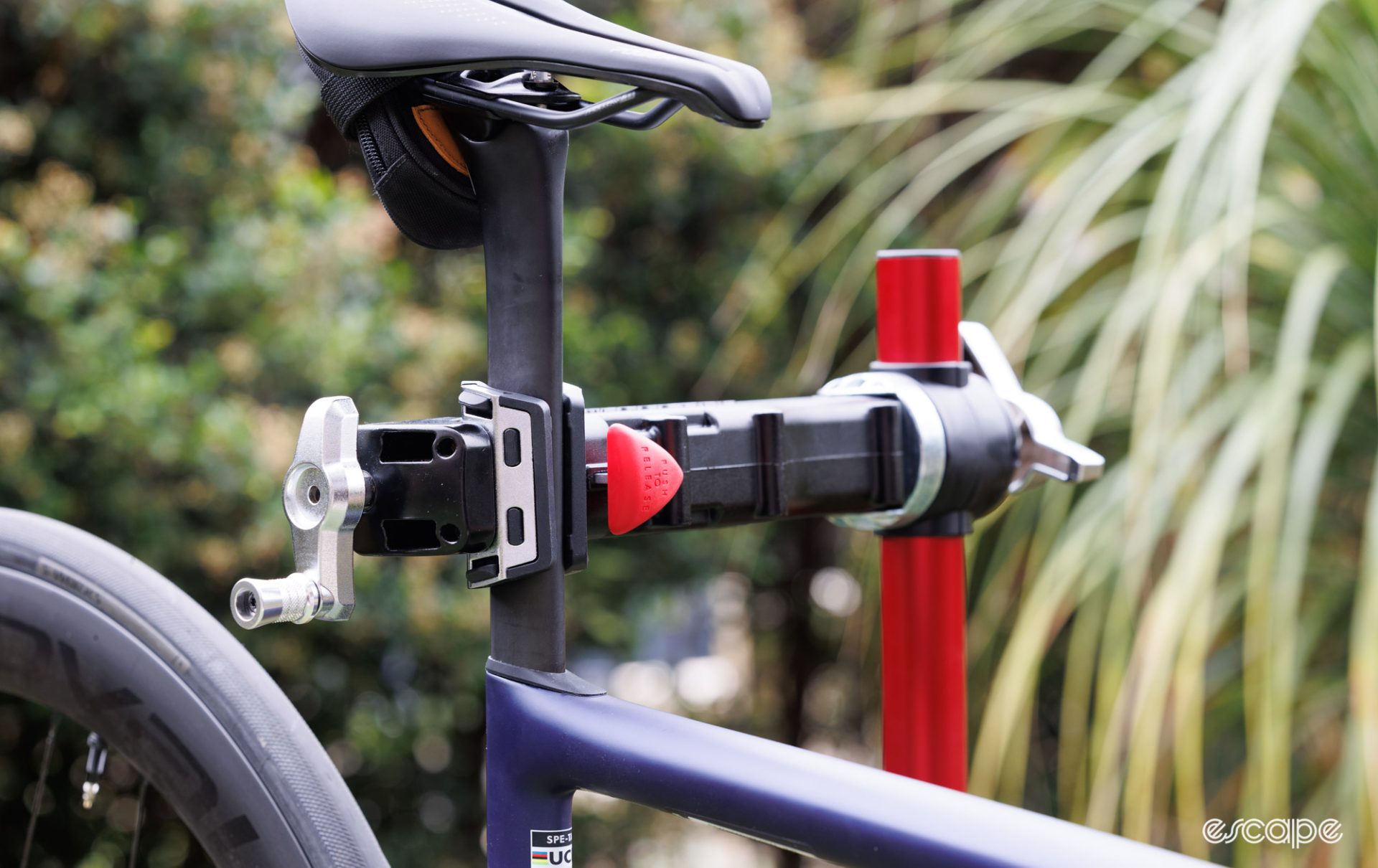
Here, most of these weird seatpost shapes are pinched against the frame either at the front or back, meaning additional material support is given to handle these loads. Many deeper aero seatposts are then made light by thinning the sides of the posts to a bare minimum, and it’s not uncommon for them to be so thin you can feel them squish between your fingers. The front-to-back clamping direction of the Park Tool means it clamps onto such fancy seatposts where most are reinforced to handle it. By comparison, the side-to-side clamping of the Feedback Sports means not only are some aero-shaped posts more likely to slip, some of them can quite easily be crushed into ruin (not the case with the Specialized SL8 post seen here, which fits rather perfectly in both clamps).
Ok, so there is a hack you can do with most Feedback Sports stands – including the new Pro Mechanic – to overcome this. Rather than follow the intended design by setting the clamp to come out straight from the stand, you instead set it to the side. By doing this, the clamp then holds a seatpost front-to-back. This hack typically limits access to some parts of the bike, reduces stability, and it’s not officially recommended. Still, it’s one way to get greater versatility from the stand. As a side note, the equally new and burly Pro Mechanic HD stand can’t be used in this orientation.

Not to go on too much of a tangent, but the topic of clamping onto aero seatposts is vast. Some shapes are better off not being clamped at all. Meanwhile, there are an increasing number of painted-to-match seat posts that can be high-stress to clamp to. This returns to the world where race-style repair stands are still valuable, or alternatively (my preference), a frame-holding adapter such as a Silca Hirobel (US$150) removes any such fear, and removes any concern for which direction a stand clamps in.
To reiterate, the direction of clamping is only of concern when holding aero or strangely shaped carbon fibre seatposts. If you’re only holding mountain bikes, kids’ bikes, or other things with round seat posts, then neither system is better than the other. Still, Park Tool wins this one for me based on having the most carefree compatibility.
Picking one
As I was writing this I thought the Feedback would end many points higher, yet to my surprise, the tally is seven points to Park Tool, and nine points to Feedback Sports.
This will read like I’m sitting on the fence, but picking between these two is not the easiest of decisions. In many ways Feedback Sports’ Pro Mechanic is the clear winner through its ease of folding, increased maximum height, general build quality, speed of clamping, and aesthetic design. However, the direction that its clamp is designed to work in isn’t ideal for a holding number of lightweight aero-shaped seat posts – and here, the Park Tool holds a compatibility advantage.
If you only ever work on bikes with round or D-shaped seatposts, and/or are willing to buy a frame adapter such as the Silca Hirobel for aero road or tri bikes, then the Feedback Sports Pro Mechanic is my first pick. On the other hand, if you regularly work on such fancy road bikes and refuse to use any additional accessories, then Park Tool’s clamp makes that stand the better option. And if both of these are simply too expensive, then I’ll still encourage you to buy from a brand that offers long-term support for its products.
Happy wrenching!

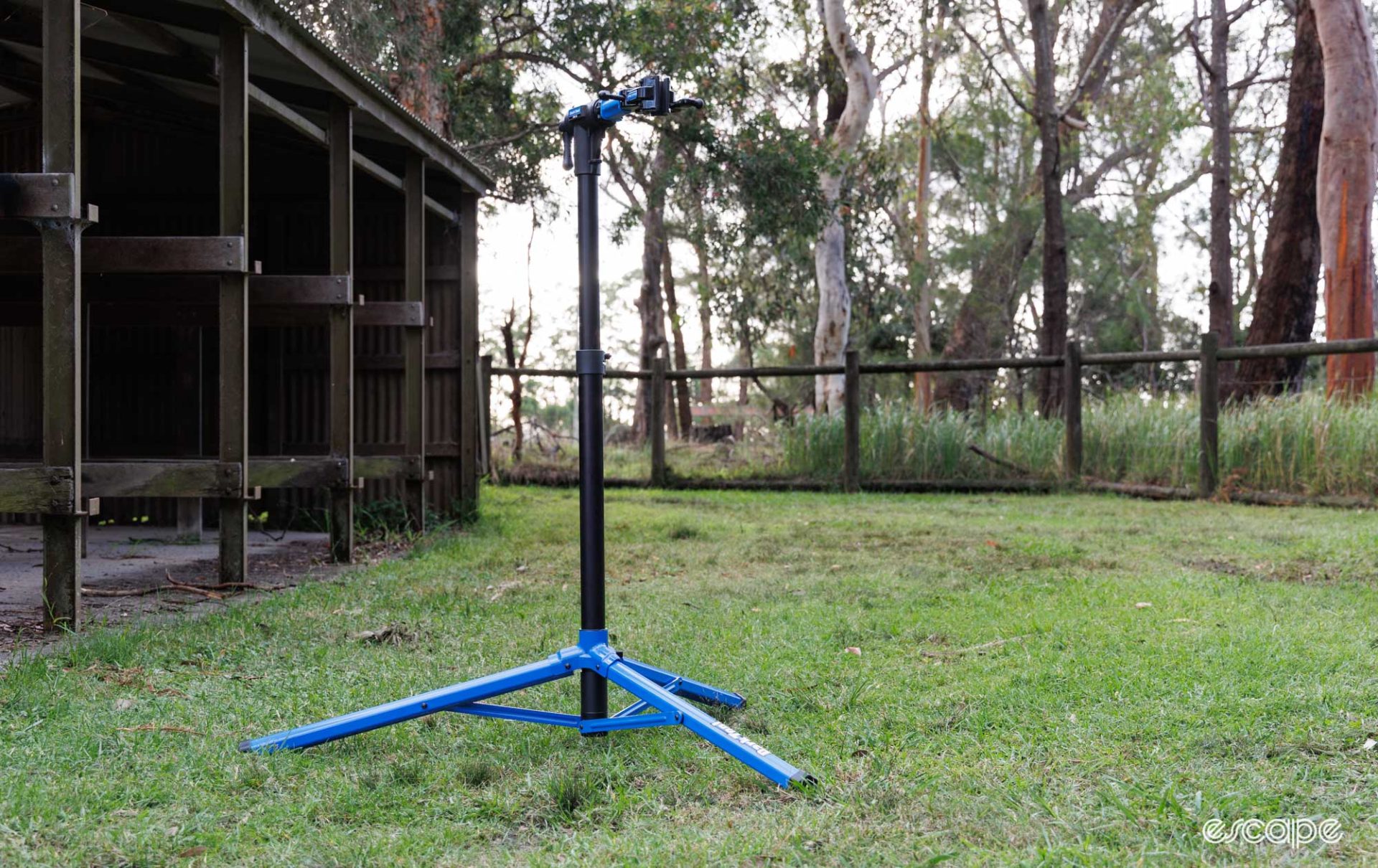
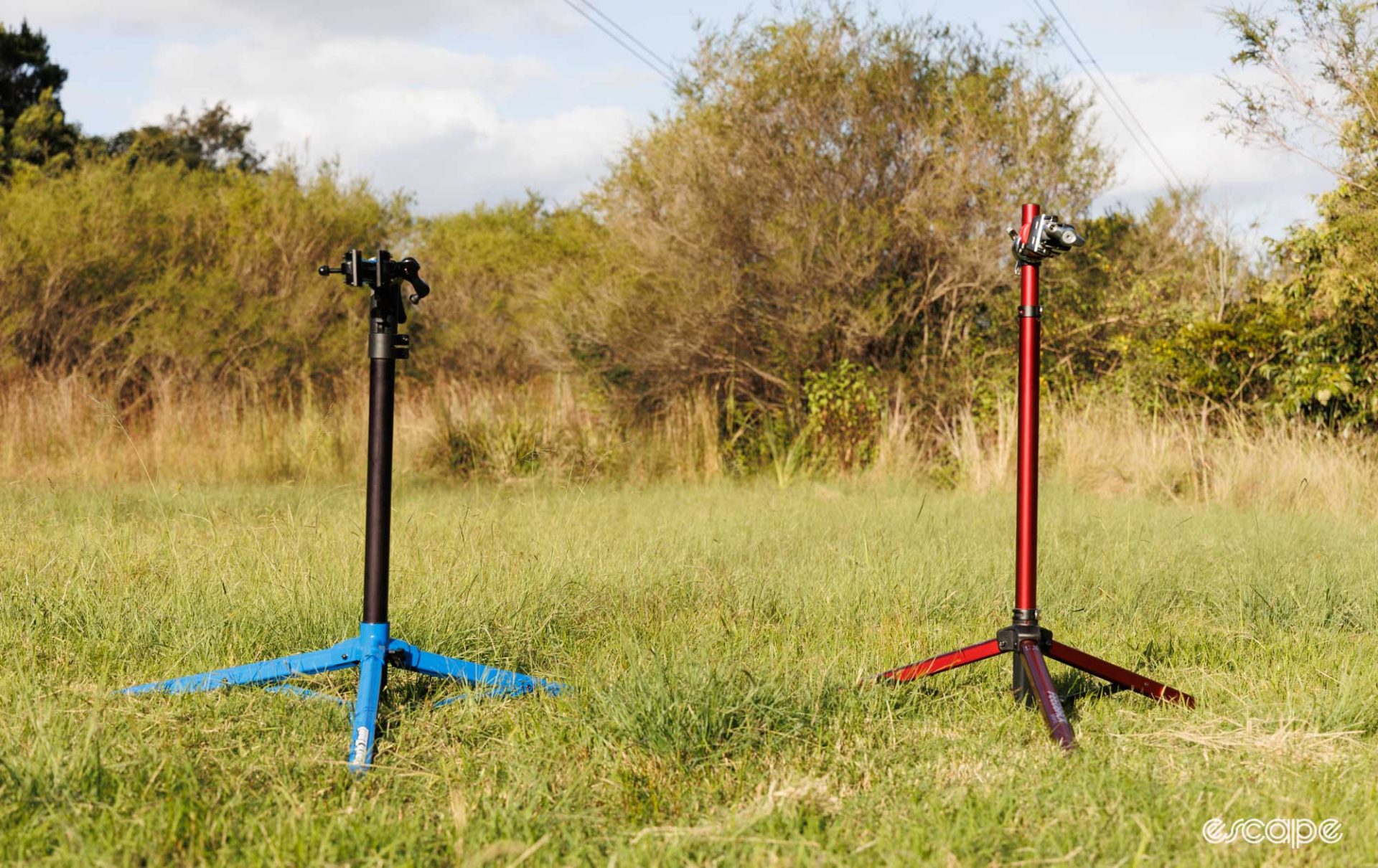

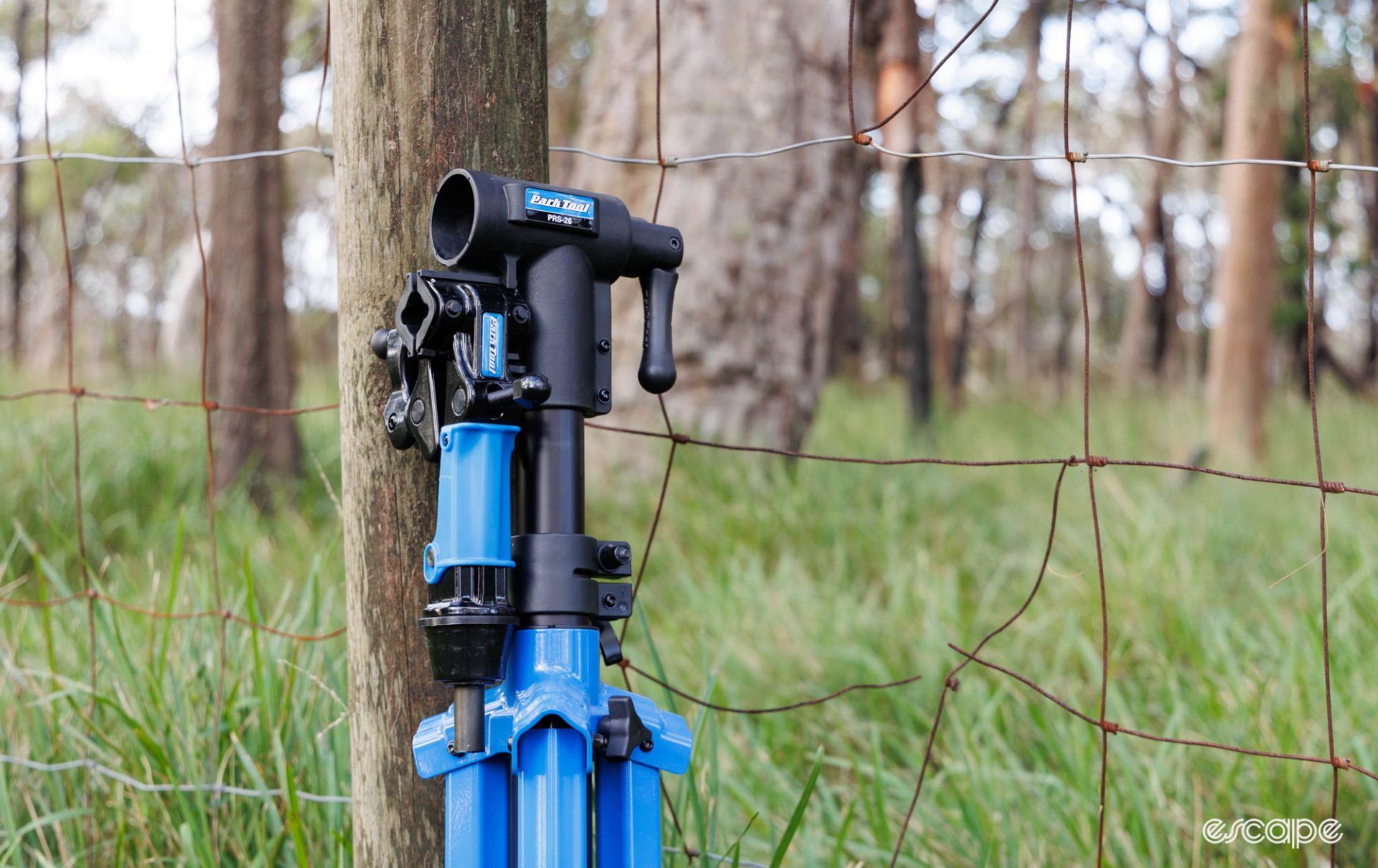
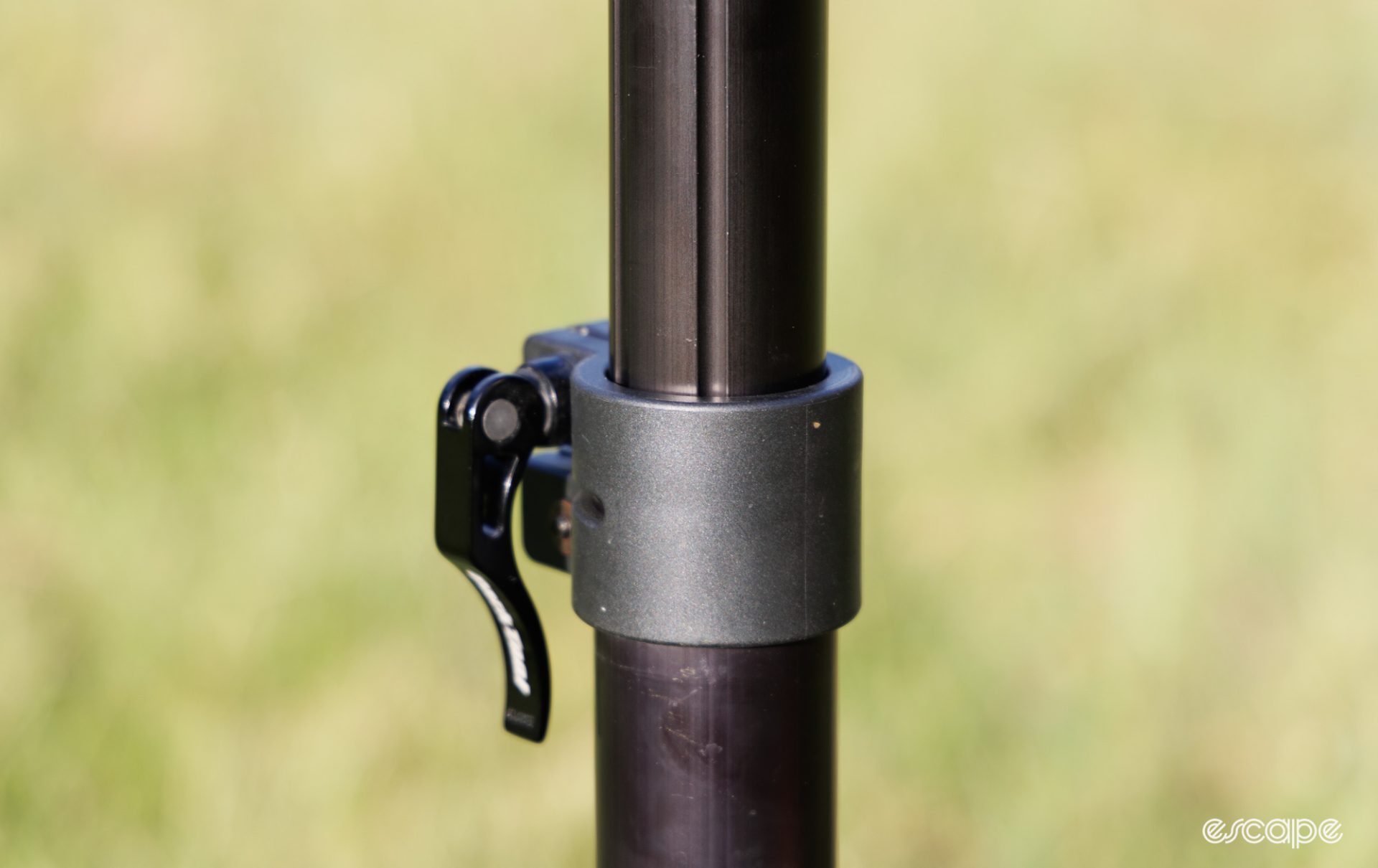
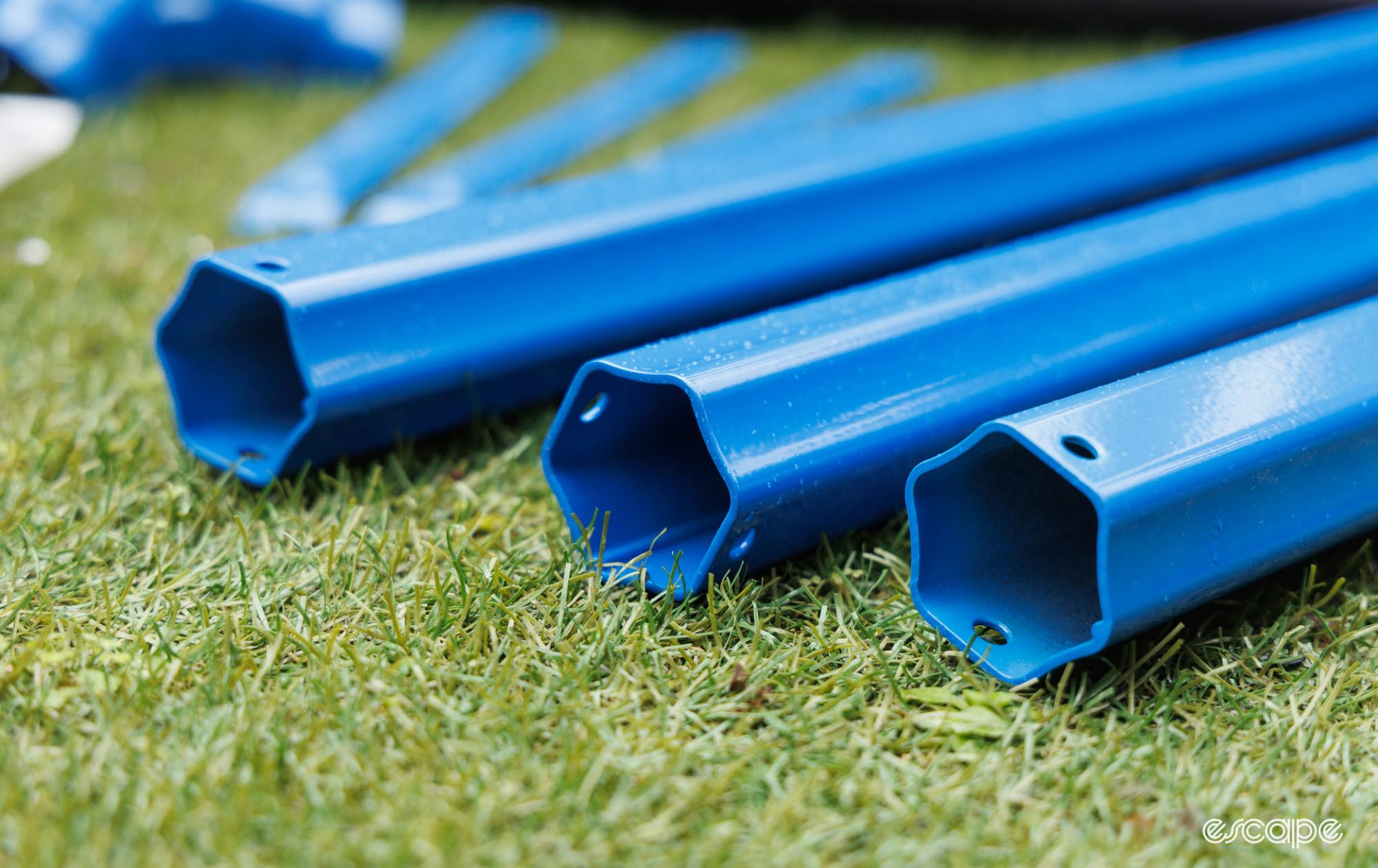
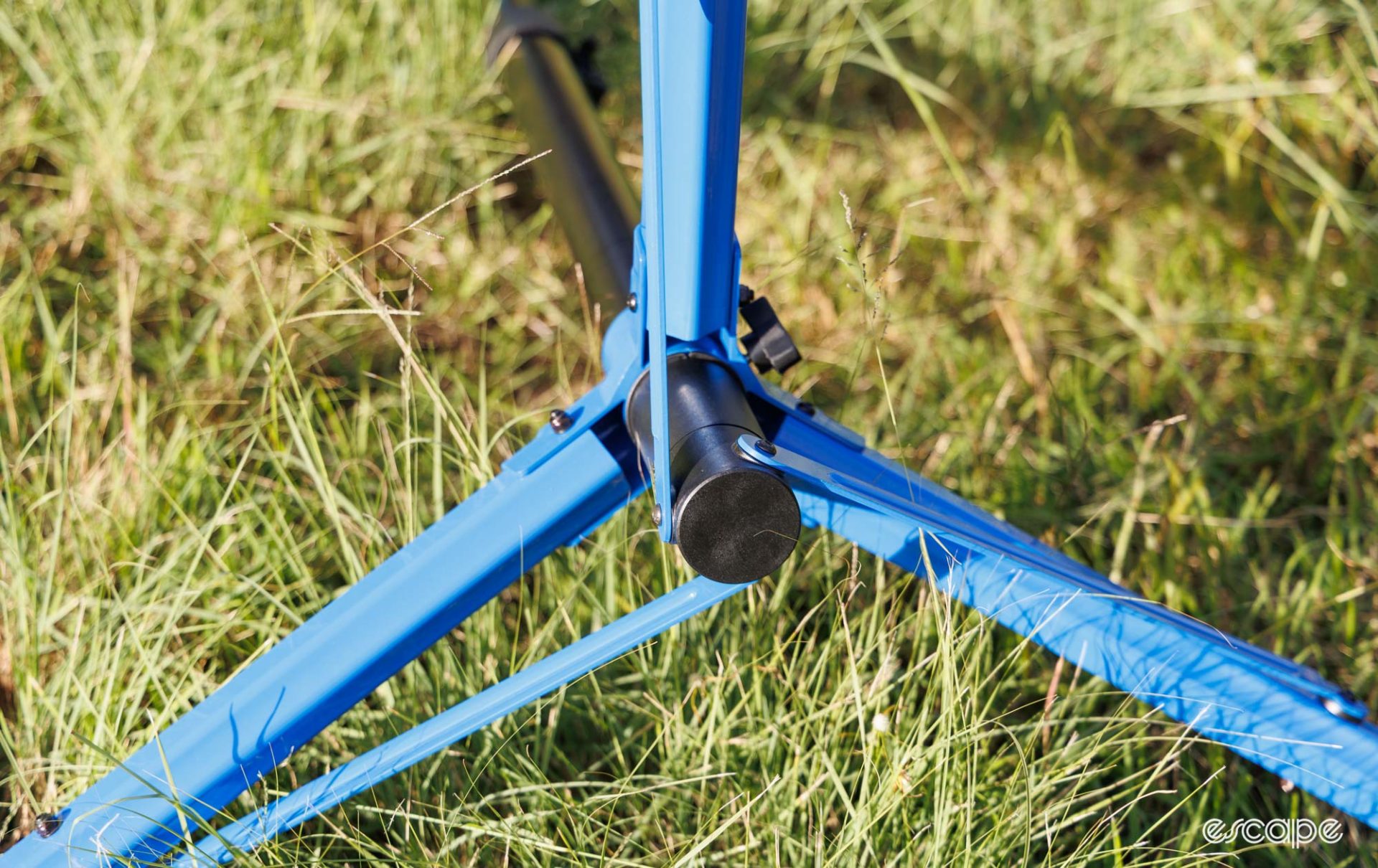
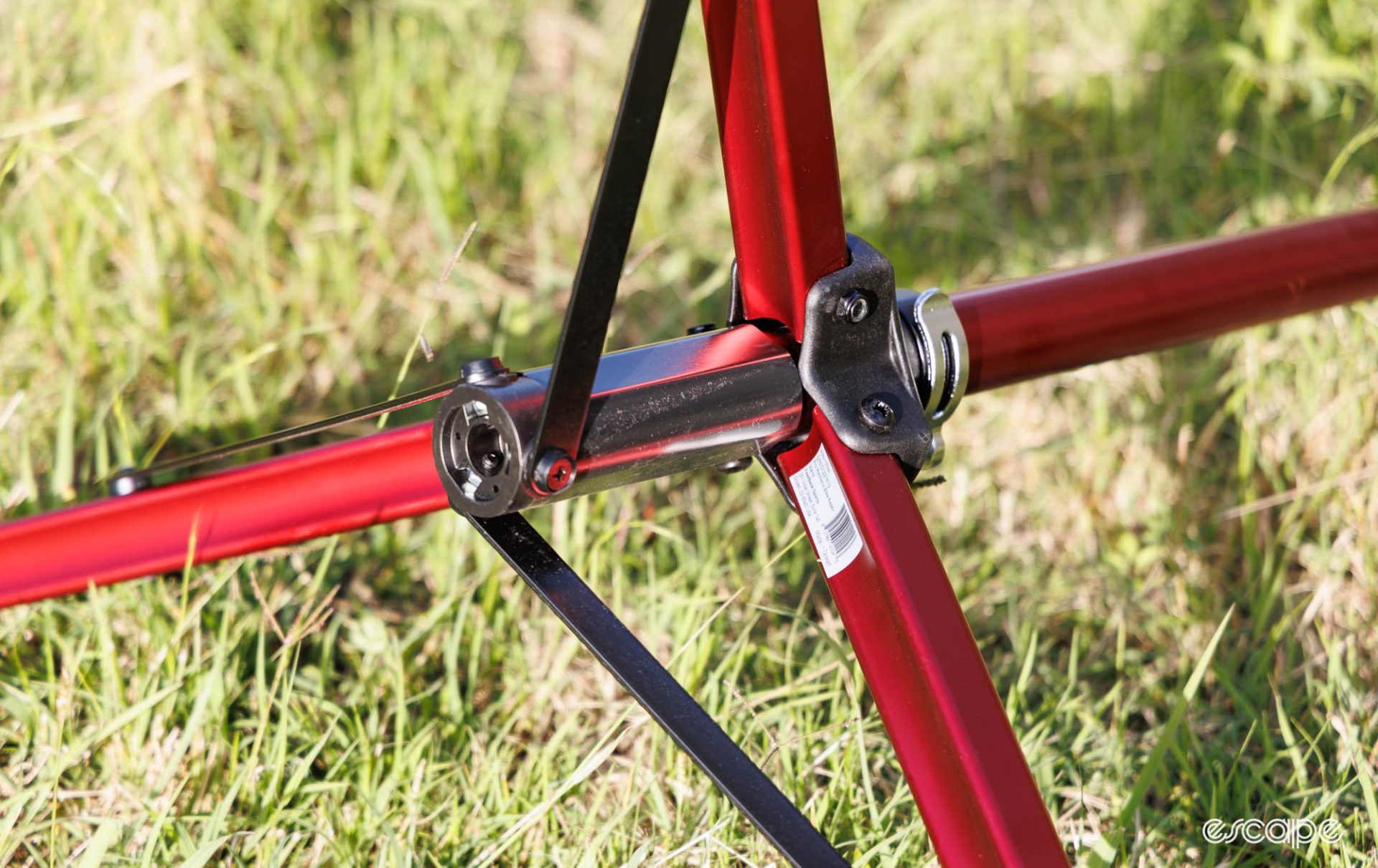
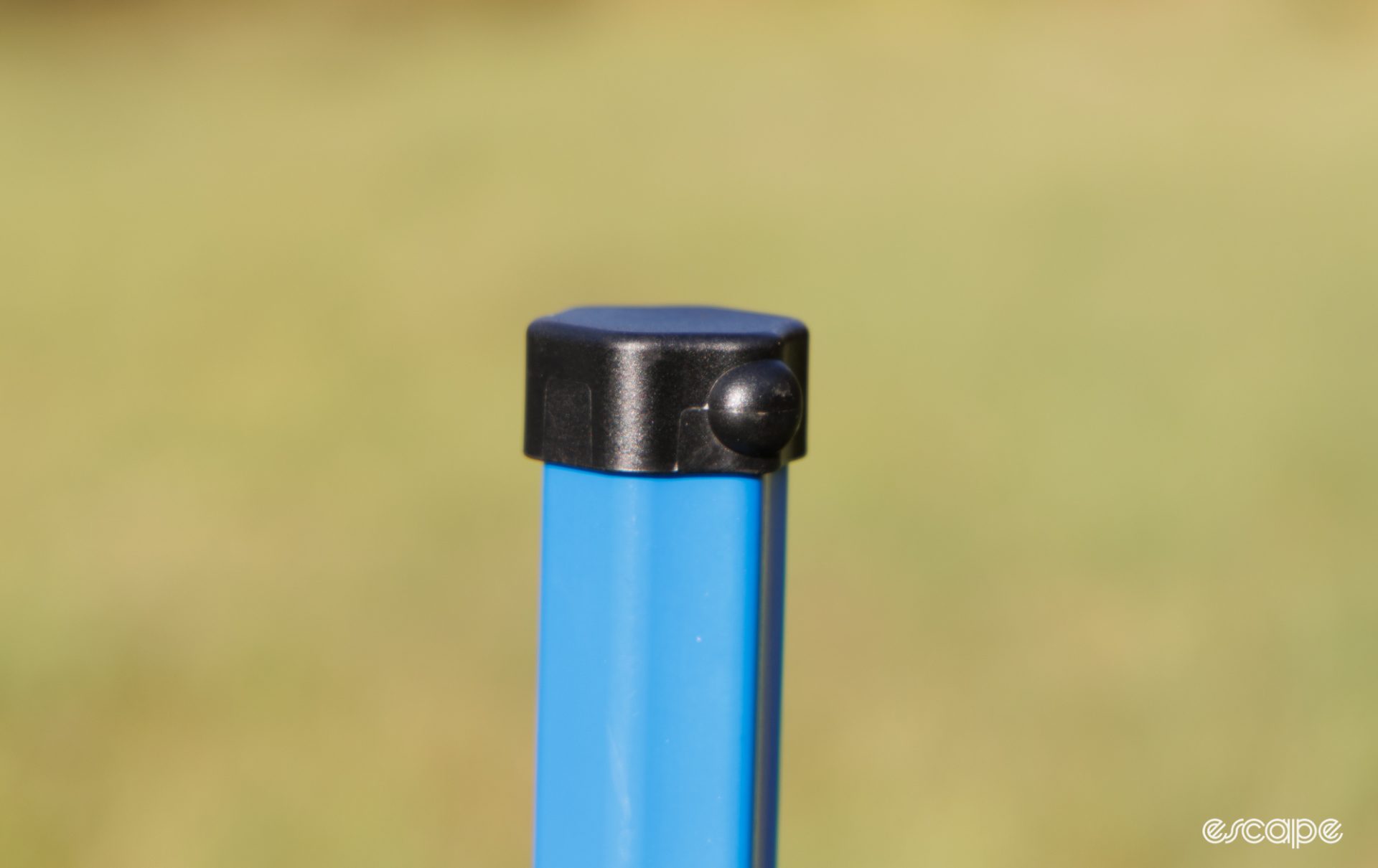


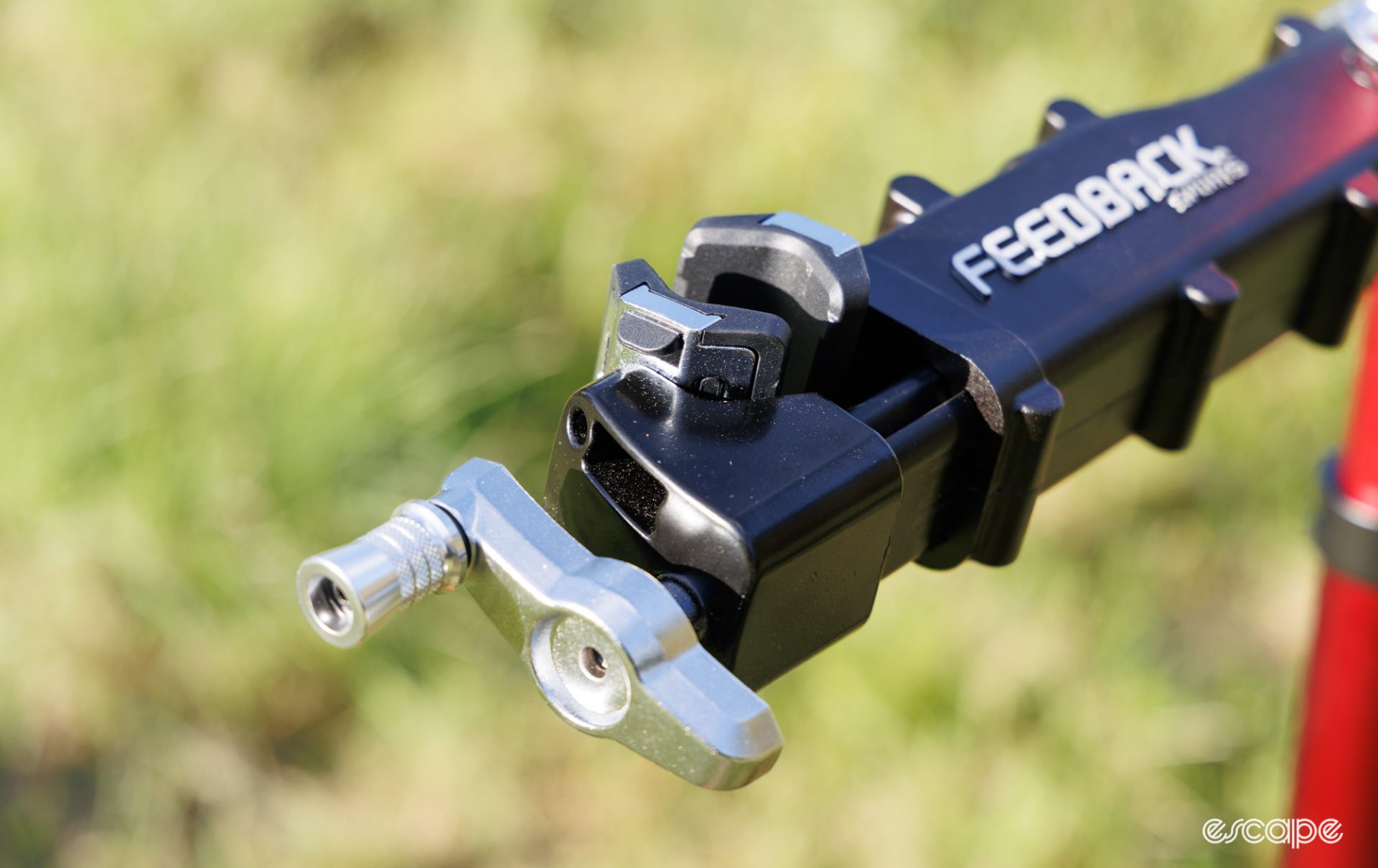
Did we do a good job with this story?
